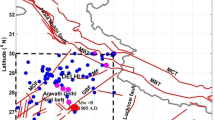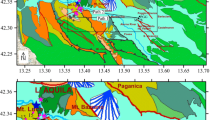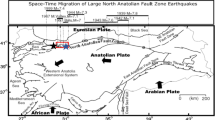Abstract
The Sannio seismogenic area turns out to be responsible for the highest peak ground accelerations (PGA) and seismic response spectra (SRS) at Napoli. The 1688 earthquake is considered representative of the area, and realistic synthetic seismograms have been computed for this scenario earthquake at the historical center and the eastern sector of Napoli. The use of a hybrid technique based on mode summation and finite-difference methods is fully justified by the available detailed knowledge about the geological and geophysical properties of the Neapolitan subsoil. This modeling makes it possible to recognize that amplifications of ~2 for PGA and >3 for SRS are to be expected because of the pyroclastic soil cover. Based on the information contained in the available catalogs, different magnitudes have been considered. Taking into account the correlation, valid for the Italian territory, between synthetic PGA and observed intensities, it turns out that the most probable magnitude (M) of the 1688 earthquake is 6.7, while M = 7.3 should be assigned to a conservative scenario earthquake. Comparison of the computed response spectra for the 1688 scenario earthquake with the Italian seismic building code shows that the code is adequate with respect to the expected effects at the historical center of Napoli, but that it underestimates the possible ground motion at the eastern sector, in particular at the newly developed area built after the 1980 earthquake.










Similar content being viewed by others
References
Aki, K., Strong motion seismology: Strong Ground Motion Seismology, NATO ASI Series, Series C: Mathematical and Physical Sciences (eds. M.O. Erdick and M.N. Toksöz) (D. Reidel Publishing Company, Dordrecht 1987, 204, 3–39).
Baratta, M., I terremoti d’Italia (Torino 1901) (rist. anast., Bologna 1979), 950 pp.
Boschi, E., Guidoboni, G., Ferrari, G., Mariotti, D., Valensise, G., and Gasperini, P. (2000), Catalogo dei Forti Terremoti in Italia dal 461 a.c. al 1997, Annali di Geofisica 43(4), 268 pp.
Camassi, R. and Stucchi, M. (1997), NT4.1, un catalogo parametrico di terremoti di area italiana al di sopra della soglia del danno. http://emidius.mi.ingv.it/NT/home.html.
Esposito, E., Porfido, S., Luongo, G., and Petrazzuoli, S. M. (1992), Damage scenarios induced by the major seismic events from XV to XIX century in Naples city with particular reference to the seismic response, Earthquake Engineering, Tenth world conference, 1075–1080.
Florsch, N., Fäh, D., Suhadolc, P., and Panza, G. F. (1991), Complete synthetic seismograms for high-frequency multimode SH-waves, Pageoph 136, 529–560.
Gel’fand, I., Guberman, S. H., Izvekova, M., Keilis-Borok, V. F., and Rantsman, E. (1972), Criteria of high seismicity determined by pattern recognition, Tectonophysics 13(1/4), 415–422.
Gel’fand, I., Guberman, S. H., Keilis-Borok, V. F., Knopoff, L., Press, F., Rantsman, E., Rotwain, I., and Sadovsky, A. (1976), Pattern recognition applied to earthquake epicentres in California, Phys Earth Planet Inter 11, 227–283.
Gorshkov, A. I., Panza, G. F., Soloviev, A. A., and Aoudia, A. (2002), Morphostructural zonation and preliminary recognition of seismogenic nodes around the Adria margin in peninsular Italy and Sicily, J Seismol Earthq Eng 4, 1–24.
Gruppo di Lavoro CPTI (2004), Catalogo Parametrico dei Terremoti Italiani. http://emidius.mi.ingv.it/CPTI/.
Guadagno, F. M., Nunziata, C., and Rapolla, A. (1992), Dynamic parameters of volcaniclastic soils and rocks of Campi Flegrei (Naples, Italy). Volcanic Seismology, IAVCEI Proceedings in Volcanology, Springer-Verlag, 533–546.
Gusev, A. A. (1983), Descriptive statistical model of earthquake source radiation and its application to an estimation of short period strong motion, Geophys J R Astron Soc 74, 787–800.
Nunziata, C. (2004), Seismic ground motion in Napoli for the 1980 Irpinia earthquake, Pageoph 161(5/6), 1239–1264.
Nunziata, C., Costa, G., Marrara, F., and Panza, G. F. (2000), Validated estimation of the response spectra for the 1980 Irpinia earthquake in the eastern area of Naples, Earthq Spectra 16(3), 643–660.
Nunziata, C., Natale, M., and Panza, G. F. (2004), Seismic characterization of neapolitan soils, Pageoph 161(5/6), 1285–1300.
Nunziata C., Natale M., Imperio F., and Panza G. F. (2006), Realistic ground motion scenarios for Napoli. Proceedings of the 8th U.S. National Conference on Earthquake Engineering, San Francisco. Paper No. 819, 10 pp.
Nuove Norme Tecniche per le Costruzioni, D.M. 14.01.2008, G.U. n.29 del 04.02.2008, Suppl. Ordinario n.30.
Panza, G. F. (1985), Synthetic seismograms: The Rayleigh waves modal summation, J Geophys 58, 125–145.
Panza, G. F., Vaccari, F., and Cazzaro, R., Deterministic seismic hazard assessment. In Vrancea Earthquakes: Tectonics, Hazard and Risk Mitigation. (ed. F. Wenzel et al.) (Kluwer Academy Publishers, 1999, 269–286).
Panza, G. F., Romanelli, F., and Vaccari, F. (2001), Seismic wave propagation in laterally heterogeneous anelastic media: theory and applications to seismic zonation, Adv Geophys 43, 1–95.
Peresan, A., Costa, G., and Vaccari, F. (1997), CCI1996: the current catalogue of Italy, Internal Report IC/IR/97/9. Miramare-Trieste, April 1997.
Peresan, A., Panza, G.F., Gorshkov, A.I., and Aoudia, A. (2002), Pattern recognition methodologies and deterministic evaluation of seismic hazard: a strategy to increase earthquake preparedness. Bollettino della Società Geologica Italiana 1, 37–46.
Valensise G. and Pantosti D. (eds.) (2001), Database of Potential Sources for Earthquakes Larger than M 5.5 in Italy, Annali di Geofisica 44(4), 180 pp., with CD-ROM.
Author information
Authors and Affiliations
Corresponding author
Rights and permissions
About this article
Cite this article
Nunziata, C., Sacco, C. & Panza, G.F. Modeling of Ground Motion at Napoli for the 1688 Scenario Earthquake. Pure Appl. Geophys. 168, 495–508 (2011). https://doi.org/10.1007/s00024-010-0113-1
Received:
Revised:
Accepted:
Published:
Issue Date:
DOI: https://doi.org/10.1007/s00024-010-0113-1




